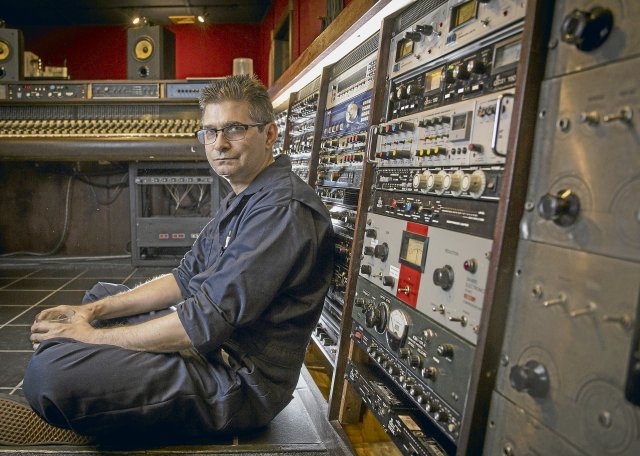Steve Albini managed to integrate new attitudes into his thinking and his music without ever becoming a (left-wing) liberal.
Photo: Brian Cassella/TNS via ZUMA Press Wire/dpa
Evil sawing guitars, a grooving bass and stoic, pounding drums from the Roland TR-606 drum machine were the sonic brand core of the noise rock band Big Black, founded by Steve Albini in Chicago in 1981. Albini would probably have been angry about the term “brand core” – for him, music and music-making should never become a commodity.
With his two bandmates Santiago Durango (guitar) and Jeff Pezzati (bass), who was replaced by Dave Riley in 1984, he was largely responsible for the US underground, which was heavily influenced by hardcore punk in the early 80s, opened up to more experimental and longer forms. Inspired by British post-punk bands such as Sonic Youth, Butthole Surfers and Naked Raygun, among others, released on independent labels such as SST, Homestead and Touch and Go; Albini himself was to remain loyal to the latter throughout his life. However, this extremely productive phase of subcultural guitar music was quickly followed by the integration of many bands into the oligopolistic cultural industry, which then fueled the grunge boom in the 90s. Big Black, however, broke up in 1987. With their music and Albini’s lyrics, which were primarily about alienated and broken characters, murderers, pyromaniacs and sexists, they wouldn’t have been particularly suitable for mass appeal anyway. Albini, who also worked as a journalist, criticized the developments in the indie scene towards commercialization extremely sharply and also polemicized against former companions such as Sonic Youth.
With David WM. Sims (bass) and Rey Washam (drums), he founded the short-lived (1987–1989) band Rapeman, which was very provocatively named after a manga character. In later years, Albini repeatedly emphasized that he was saddened by this naming in retrospect. The band acted more as a link between Big Black and Albini’s most consistent band, Shellac. His squeaky metallic guitar met a rhythm section that played proto-math rock, which also repeatedly made excursions into broken blues. By the way, you could later hear it in its purest form with The Jesus Lizard, another band that Sims co-founded in 1987.
With Shellac in 1992, Albini found the final form of his work as well as his long-time collaborators Bob Weston (bass) and Todd Trainer (drums). Having now become an experienced and well-known sound engineer, having recorded albums with and for Pixies, The Breedes and Slint, among others, Albini was able to record a straightforward, direct sound and get it on tape that perfectly matched the sound the minimalist and precise playing of the three musicians. If you want to get an impression of Shellac’s music, you have to imagine a mixture of Don Caballero and ZZ Top that is confusing at first glance, but ultimately makes complete sense.
The band remained true to Steve Albini’s work ethic: they only toured when there was time and desire, releases did not follow the rhythms of the music industry and merchandise in the form of T-shirts was only sold from the stage. However, this ethos was never transfigured into a fetish and in Albini’s work – whether in his role as a musician, sound engineer or journalist – there always appeared an idea of the worker that did not fit into the identitarian cliché of schnitzel (or better: Chicago Italian beef sandwich), canned beer and football regressed. And also an idea of work in which knowledge and skills, effectiveness and efficiency are used to create the best possible product, not as a means to increase profitability.
Music was an end in itself, not a means to make money. And yet Albini’s music did not merge into a formalistic L’art pour l’art, as was repeatedly observed with his contemporaries Sonic Youth. On the other hand, neither Shellac nor Albini’s other bands have ever fallen back into the political-moralistic discourse of hardcore. The subjects of the texts were repeatedly broken ironically, whether through the sound structure or through exaggerations and puns on a textual level. And it is also Albini himself who is the break. His extremely petite body, at least in his younger years, his circular glasses, his voice that quickly changes from over-emphasized, yapping to soft, melancholic: all of this never gave rise to the idea, especially on stage, that he was affirmatively engaging with, for example, masculinist figures. Especially live, Shellac always presented clowning in the best possible sense.
In the later years, Albini’s provocations decreased somewhat, without any weariness from old age setting in. He repeatedly made angry statements about politics and the music business. However, in contrast to quite a few men who were socialized in punk, he knew how not to resort to a clumsy counter-position, which in the end is just an affirmation of the existing situation. He was able to integrate new attitudes into his thinking and his music without bending and becoming a (left-wing) liberal. And musically, Shellac also remained surprisingly consistently at a high level. They were conservative in the best sense, preserving the most interesting moments of US punk culture, but at the same time abolishing and developing them through constant transformation or rearrangement. This event was presided over by Steve Albini, who, despite all his anger, never stopped thinking, and the anger drove him on without allowing himself to be driven. On May 7th he died of a heart attack.
Become a member of the nd.Genossenschaft!

Since January 1, 2022, the »nd« will be published as an independent left-wing newspaper owned by the staff and readers. Be there and support media diversity and visible left-wing positions as a cooperative member. Fill out the membership form now.
More information on www.dasnd.de/genossenschaft
judi bola online link sbobet judi bola online sbobetsbobet88judi bola
